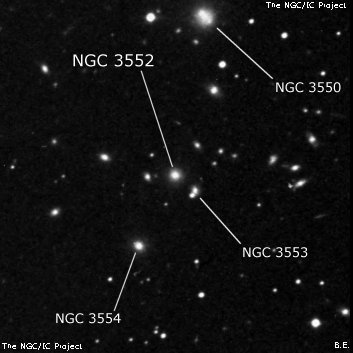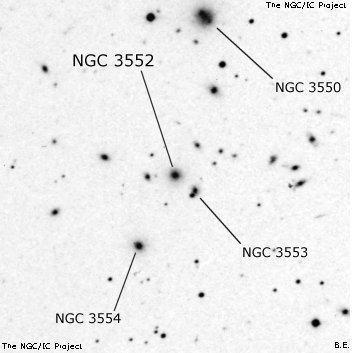NGC/IC Project Restoration Effort
(This is a very very beta version)
NGC3552


Basic Information
Location and Magnitude
Right Ascension: 11:10:42.8
Declination: +28:41:35
Constellation: UMA
Visual Magnitude: 13.7
Historic Information
Discoverer: Herschel W.
Year of discovery: 1785
Discovery aperture: 18.7
Observational
Summary description: eF, vS, 2nd of 4
Sub-type: E-S0
Corwin's Notes
=====
NGC 3552 and NGC 3553. William Herschel found two objects in 1785, and
reobserved them in 1790, providing them with separate positions then. John
Herschel has several sweeps over the area, finding four objects altogether.
D'Arrest observed the same four galaxies, and picked up a fifth about 10
arcmin south. A sixth was found in 1885 by Bigourdan who also provided
accurate positions for the other four (he also has one observation of a
"nova" in the field, but his estimated position points at blank sky; see the
discussion of this under NGC 3561). These six nebulae were included in NGC.
Lord Rosse did not observe (or at least left no record of) any of them. If he
had, there would almost certainly be more than the six objects in NGC that
there are, since these six NGC objects are the brightest in the cluster Abell
1185.
At least two other "historical" observations of Abell 1185 exist. First,
Kobold measured accurate positions in 1902 for five objects here (one, which
he called "Kobold 13," was discovered by him). One of his positions (for
N3552) points at blank sky. Three other of his positions are systematically
off the galaxies by about 20 arcsec. Because of the supposed care with which
Kobold did his work, Hubble (in his PhD thesis, published in 1917) was misled
into questioning his own work in the area where he measured positions and
estimated types for several dozen galaxies. We'll come back to this
particular problem in a bit.
With all these positions and observations, one can be excused for believing
that all is well, and that we know exactly which NGC number applies to which
object. Not true! Only the numbers for three of the six NGC galaxies are
pretty solid (N3550, N3554, and N3558). Questions arise for the other three.
If we restrict ourselves to the early observations, we can be pretty sure
which objects were seen by the Herschels and by d'Arrest -- the brightest five
galaxies. While the positions are not exact, they are good enough to pin down
the correct objects. The problems begin with Bigourdan's observations. While
his positions (reduced using GSC positions for his comparison stars) are
excellent, he assigned the number N3553 to the object which John Herschel and
d'Arrest called N3552. For N3552, he chose a faint galaxy about an arcminute
south-preceding. It has a brighter star superposed -- it is actually this
star which Bigourdan measured; he describes the two objects as a single faint
nebulous spot. Dreyer adopted Bigourdan's position for N3553. It's no
surprise then, that the NGC positions for N3552 and 3553 are very close --
they apply to the same object.
For this catalogue, we've followed historical precedent, and assigned the
number N3552 to the brighter north-following object, leaving the
south-preceding object (the one first seen by Bigourdan) as N3553. This is
counter the prevailing idea that lower NGC numbers are always preceding, but
explicitly acknowledges the actual history of the observations.
Well, I promised a brief discussion of Kobold's and Hubble's data. Kobold's
mistake, not found by Hubble, was a transposition of two numbers in the
declination measurement of his comparison star with respect to an FK1
reference star (the comparison star is actually the same star used by
Bigourdan for most of his measurements). This transposition (instead of -9'
42.5" as used and published by Kobold, read -9' 24.5") resulted in a
systematic error of 18.6" in his declinations of N3550, N3552, N3554, and
K13. Once corrected, the positions of N3550, N3554, and K13 agree very well
with those measured by Bigourdan, by Hubble, and with those in GSC. However,
Kobold's position for N3552 points at blank sky -- there is nothing within 3
arcmin in any direction brighter than the POSS1 plate limit. I suspect that
Kobold's offsets apply to another star/galaxy pair, but I've not been able to
find which objects would fit (I admit to not having looked very hard; perhaps
a reader could unravel the mystery).
In any event, Kobold's systematic error misled Hubble into thinking that his
positions, measured on a plate taken with the 24-inch reflector at Yerkes
Observatory, were somehow incorrect. In the end, however, Hubble printed his
own positions and identifications. His positions are quite good, but his
identifications are wrong for N3552 (he got K13) and N3554 (he got N3552); he
did not identify N3553 at all -- but it is his number 81 in his Table XI.
Steve's Notes
=====
NGC 3552
13.1" (3/24/84): very faint glow that is slightly brighter than NGC 3553, situated very close SW just 44" from center. Located in the core of AGC 1185.



